Squid ink pasta is one of those dishes that feels like a secret handshake among seafood lovers. The inky blackness is dramatic, yes, but it’s also packed with a briny, smoky flavor that transports you straight to the seaside—no matter where you are. I love how quick it is to make, yet it feels so indulgent, like a little treasure in a bowl.
Why I keep returning to this dish
It’s a dish that demands attention but rewards with deep, smoky flavors and a striking look. It’s perfect on busy nights when I want something special but don’t want to fuss. The smell alone, garlic and ink simmering, always pulls me in, and the taste—salty, smoky, with a hint of citrus—never fails to surprise.
Breaking down the ingredients
- Squid ink pasta: The star—briny, slightly chewy, with a dark, mysterious look that’s as dramatic as it tastes.
- Squid ink: Brings that smoky, oceanic depth—use fresh or good-quality canned for best flavor.
- Garlic: Aromatic, pungent; it wakes up the dish—don’t skimp on fresh cloves.
- Olive oil: Rich and fruity, it forms the base—go for extra virgin for the best flavor.
- Lemon juice: Brightens everything—use fresh, and don’t be shy with the zest.
- Chili flakes: Adds a gentle heat—adjust to your spice level.
- Parsley: Fresh and herbal, it cuts through the richness—use flat-leaf for a punch.
Tools of the trade for squid ink pasta
- Large pot: To boil the pasta efficiently, giving enough space for even cooking.
- Wide skillet: To sauté garlic and toss pasta easily, ensuring even coating.
- Tongs or pasta spoon: To handle and serve the hot pasta without breaking it.
- Measuring spoons: To measure salt, oil, and lemon juice accurately.
Step-by-step to perfect squid ink pasta
Step 1: Fill a large pot with water, add salt, and bring to a rolling boil—like ocean water, really. About 1 tablespoon per liter of water.
Step 2: Add the squid ink pasta and cook according to package instructions, usually 8-10 minutes, until al dente—firm with a slight chew.
Step 3: While pasta cooks, heat a good splash of olive oil in a wide skillet over medium heat—around 160°C/320°F—until shimmering.
Step 4: Add minced garlic and a pinch of chili flakes, sauté until fragrant, about 1 minute, and the garlic just begins to turn golden.
Step 5: Drain pasta, reserving about ½ cup of pasta water. Toss pasta into the skillet with the garlic oil, adding a splash of reserved water to loosen.
Step 6: Finish with a squeeze of lemon juice and a sprinkle of chopped parsley for brightness—taste and adjust seasoning.
Step 7: Serve immediately, with a drizzle of good olive oil and a few more chili flakes if you like heat.
Cooking checkpoints for squid ink pasta
- Pasta is al dente—bite into a strand and it should offer a firm resistance.
- Garlic is golden, not burnt—keep the heat moderate to avoid bitterness.
- The sauce should cling to the pasta—add a splash of reserved water if it feels dry.
- The ink’s vibrant color should remain vivid—overcooking can dull its hue, so watch closely.
Common mishaps and how to fix them
- Cooking pasta too long.? If pasta is overcooked, drain immediately and rinse with cold water to halt cooking.
- Sauce is dry or claggy.? If sauce is too thick, add more reserved pasta water until it loosens up.
- Burning garlic.? If garlic burns and turns bitter, lower the heat and add a splash of water to cool.
- Overcooking the ink or adding too early.? If ink loses its deep color, cook pasta slightly less and add ink just before serving.
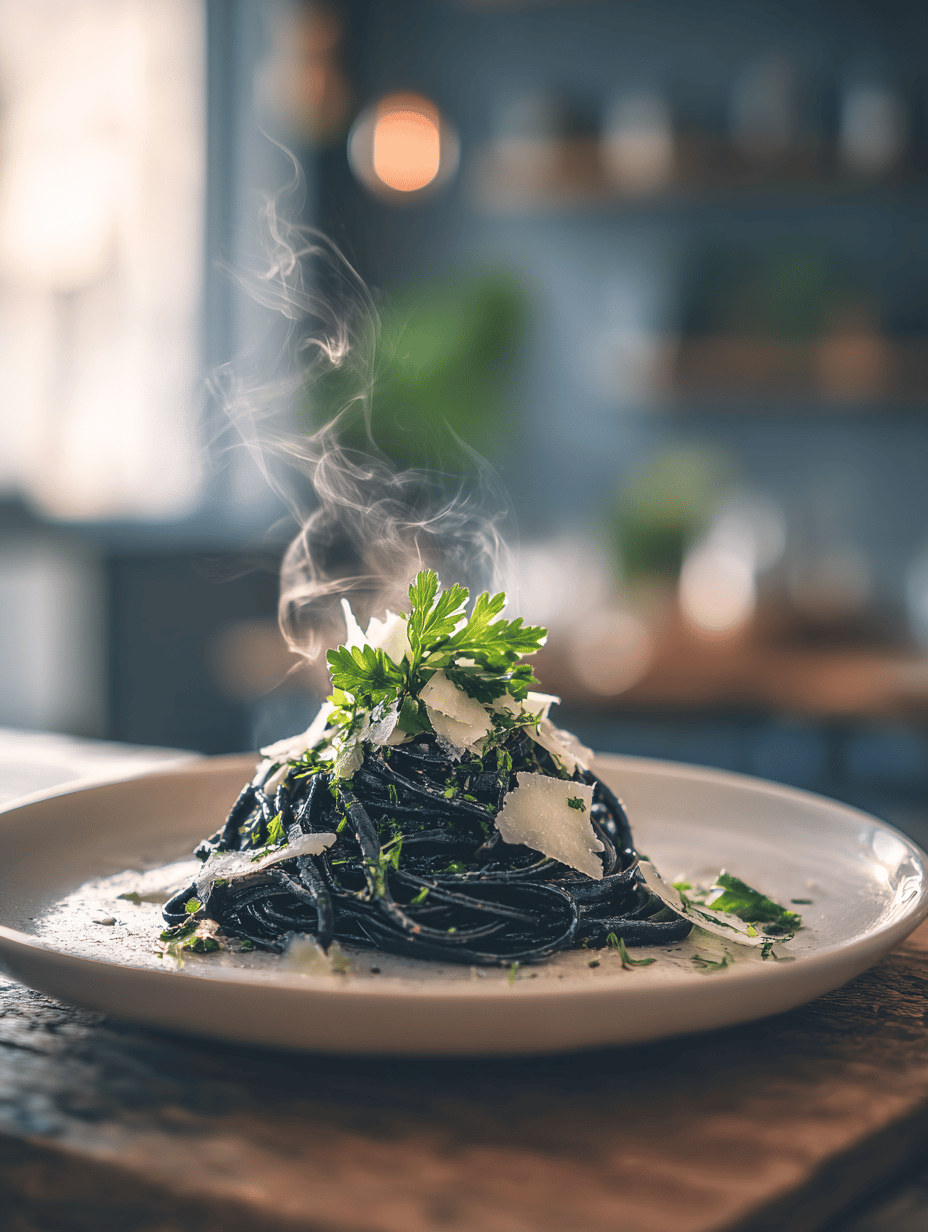
Squid Ink Pasta
Ingredients
Equipment
Method
- Fill a large pot with water, add a tablespoon of salt, and bring to a rolling boil, like ocean water.
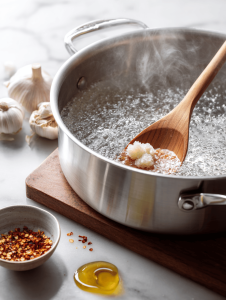
- Add the squid ink pasta to the boiling water and cook according to package instructions, usually 8-10 minutes, until al dente—firm with a slight chew.
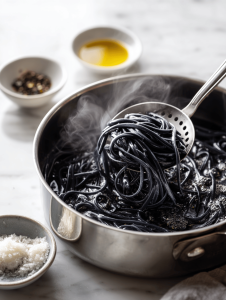
- While the pasta cooks, heat a generous splash of olive oil in a wide skillet over medium heat, listening for a gentle shimmer and aroma of olive and garlic.
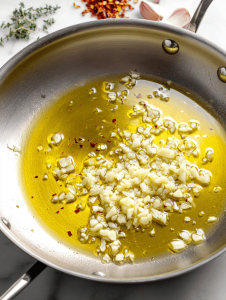
- Add the minced garlic and chili flakes to the skillet, sautéing until fragrant and golden, about 1 minute. Keep the heat moderate to prevent burning.
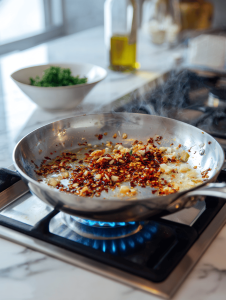
- Drain the pasta, reserving about half a cup of the cooking water. Add the pasta directly into the skillet with the garlic oil, tossing gently to coat the noodles evenly.
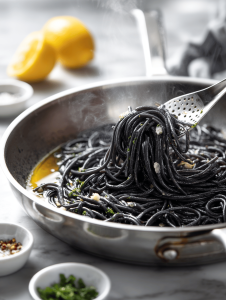
- Pour in a splash of the reserved pasta water to loosen the sauce, swirling the skillet to help the flavors meld and the sauce cling to the pasta.
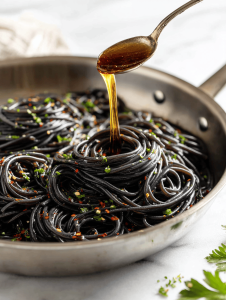
- Squeeze fresh lemon juice over the noodles and sprinkle with chopped parsley, tossing again to distribute the brightness and herbs evenly.
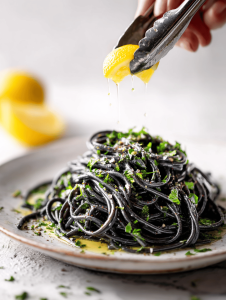
- Taste and adjust seasoning, adding more lemon, chili, or salt as needed, until the flavors are balanced and vibrant.
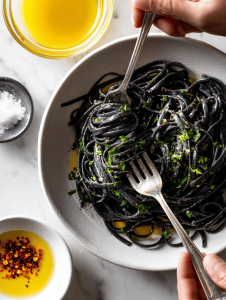
- Serve the squid ink pasta immediately, drizzled with a little extra olive oil and a few chili flakes for added heat and richness.
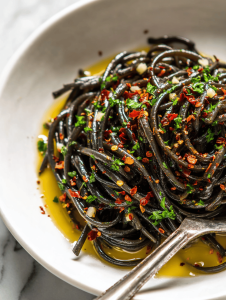

I’m Daniel Whitaker, the founder and voice behind Micromanaging Flavor. Born and raised in the United States, my love for cooking began at a young age when I realized how much joy a perfectly balanced dish could bring to the table.
